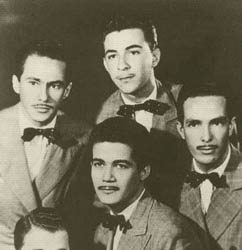The prominent bandleader Romeu Silva (1893”“1958) began as a saxophone player.
As an 18-year old postal clerk in 1911, he played in the orchestra of the
legendary rancho Ameno Resedá.
 The same year he joined the orchestra of the Sociedade Dançante Carnavalesca Ninho do Amor, whose director of harmony was the tombonist-composer ílvaro Sandim.
The same year he joined the orchestra of the Sociedade Dançante Carnavalesca Ninho do Amor, whose director of harmony was the tombonist-composer ílvaro Sandim.
In 1913, Romeu Silva followed Sandim to the rancho Flor do Abacate.
By the early 1920s, Silva was composing some tunes. Among the recordings made by the Oito Batutas in Buenos Aires are Silva’s maxixe “Tricolor” and his maxixe-samba “Si Papae Souber!”
In 1923, following a stint in Eduardo Souto’s orchestra, Romeu Silva formed his own Jazz Band Sul-Americano. This group played in balls, cabarets, and in the lobby of the Cine Palais.
In 1924, the band began recording for the Odeon label, with a repertoire that comprised sambas, maxixes, and frevos, but also American foxtrots and Argentine tangos. Their first recordings appear to have been these:
Título: Cock-tail
Gênero: Fox-trot
Intérprete: Jazz Band Sul-Americano Romeu Silva
Gravadora: Odeon
Número: 122754
Título: Cherry
Gênero: Fox-trot
Intérprete: Jazz Band Sul-Americano Romeu Silva
Gravadora: Odeon
Número: 122755 Among their early recordings (Odeon 122786) is the maxixe “Lolote ‘Estrilando’” by Mário Silva, who was most likely Romeu’s brother, for he was a longtime member of the band and bore a striking resemblance to the leader.
Among their early recordings (Odeon 122786) is the maxixe “Lolote ‘Estrilando’” by Mário Silva, who was most likely Romeu’s brother, for he was a longtime member of the band and bore a striking resemblance to the leader.
The Dicionário Cravo Albin da MPB reports that in 1925, sponsored by the Brazilian government, the Romeu Silva band toured Europe, playing mostly Brazilian genres to publicize their country’s music.
In Lisbon they played at the Teatro Trindade, going on to the Politeama, the Monumental, and Maxim’s, in addition to various nightclub gigs.
They were successful enough to have been invited to perform at the presidential palace. Appearances in other Portuguese cities followed: Figueira da Foz, Porto, Braga, Estoril, and Coimbra.
In Spain the band passed through Madrid, Barcelona, Vigo, Bilbao, and San Sebastian, always with great success. King Alfonso XII invited Romeu Silva to an event of Spanish nobles.
Then on to Paris, where the band played at the salon of the Baron de Rothschild, Maison Lafite (owned by the Rothschilds), and Château Rambouillet (the French president’s summer residence).
According to the Dicionário da MPB, Romeu Silva played at the “baile do Pétit le Blanc” (actually, le Bal des Petits Lits Blancs, an important society charity ball held at the Paris Opéra), at the inauguration of the night races at Longchamps, and at the annual ball of Sureté Génerale at the invitation of then president Albert Lebrun, proving to be the great revelation of the event.
Then the excursion continued to Belgium, Switzerland, England, Italy, and Germany. Apparently, the band accompanied Josephine Baker, and they are said to have recorded several discs with her, although I haven’t been able to establish what those recordings were.
Apparently, the band accompanied Josephine Baker, and they are said to have recorded several discs with her, although I haven’t been able to establish what those recordings were.
The claim that the latter include “La Petite Tonkinoise” is incorrect; the band on La Baker’s 1930 record is Melodie-Jazz du Casino de Paris, conducted by Edmond Mahieux. Moreover, this recording featured strings, which the Romeu Silva band lacked.
The success in Europe led to further international tours. In 1932, Romeu Silva left for the Olympic Games in Los Angeles with the Brazilian Olympic Band.
In 1935 he returned to Brazil, bringing along several American bandmembers, including Booker Pitman (sax & clarinet) and the crooner Louis Cole. For the next two years, the band played at the Cassino Atlântico.
Then, says the Dicionário da MPB, it accompanied Carmen Miranda and Bando da Lua on a one-year tour of Argentina. This part is highly questionable, since Carmen’s Argentine tour with Bando da Lua took place in 1934, she doen’t appear to have gone to that country in 1937, and in 1938 she went with her sister Aurora, but not for a year.
Whether the Jazz Band Sul-Americano accompanied Carmen Miranda on her 1938 tour remains to be established, but there’s ample evidence of another tour the band took earlier, quite undocumented in the Dicionário.
In 1937, the band went to France, most likely to perform at the Paris World’s Fair (Exposition Internationale des Arts et Techniques dans la Vie Moderne).
While there, they settled in at the famous Shéhérazade dance hall””the same one managed by the Bahian dancer Duque, where Os Batutas had played in 1922.
The Shéhérazade name is visible in the publicity photo below, circulated on the occasion of the band’s appearance in Ní®mes, an ancient Roman city in the south of France, among whose landmarks is a feature familiar to every carioca.
Orquestra Sul-Americana Brasileira in Ní®mes
(photo courtesy of Anthony Baldwin)
Billed as Orchestre da Sylva du Shéhérazade de Paris, the band was the attraction at the Bal de la Presse, which took place on Mardi Gras, 9 February 1937.
The event was a masked costume ball and spectacle organized by the Ní®mes Press Association as a benefit for the anti-tuberculosis campaign, which was financed by the sale of the souvenir stamp seen on the photo.
Anthony Baldwin, who sent me this scan, endeavored to read the musicians’ names and came up with the following, from left: Heriberto Rico; Elia [?] Lopes; —ano Mu–n-; Francisco Marti; Romeu Silva; Fernando —–; Henri Plembans [sic?]; and Mário Silva. Any reader able to shed further light on their identities is urged to do so.
In 1939, Romeu Silva was on the move again, as his orchestra was selected to appear in the Brazilian pavilion at the New York World’s Fair.
This time he had several stars under his baton, including Noel Rosa’s partner Vadico (piano), Zacarias (sax & clarinet), and Zezinho, later known as Zé Carioca (guitar).
The band was in New York from June till November, participating in a Brazilian music festival that included among its headliners the baritone Cândido Botelho (who had performed the new samba “Aquarela do Brasil” in the musical revue Joujoux e Balangandãs that very June) and the pianist Artur Rubinstein.
Upon their return to Rio, the band began to play at the Feira de Amostras, and in 1941 they moved to Cassino da Urca, the most glittering showcase in the city.
There they remained until 1946, when general Eurico Gaspar Dutra’s government outlawed gambling and all the casinos were shut down. Suddenly out of work, Romeu was forced to disband his orchestra and become a public servant. He died completely forgotten in 1958.
You can read more about Brazilian music and culture at
Daniella Thompson on Brazil here: http://daniv.blogspot.com






